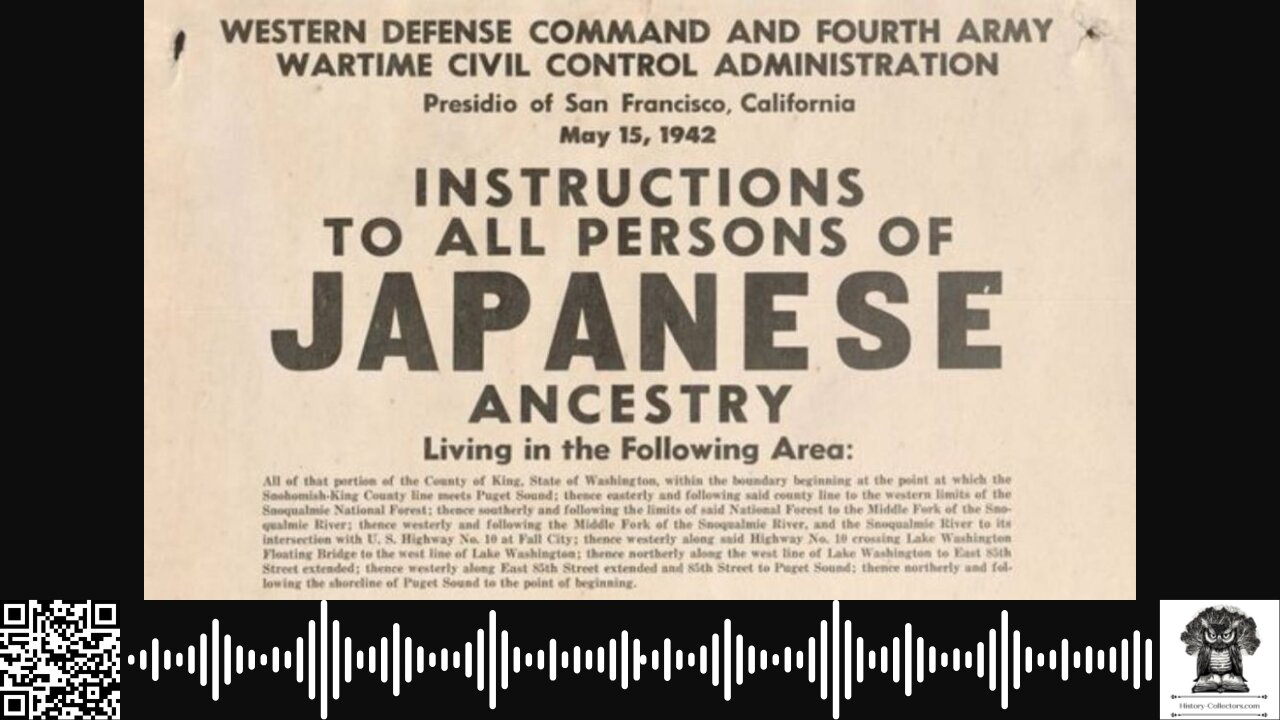Premium Only Content

#OnThisDate February 19, 1942: Internment's Injustice
https://history-collectors.com/ | Own A Piece Of History
President Franklin D. Roosevelt Signed Executive Order 9066, Authorizing The Forced Relocation And Internment Of Over 120,000 Japanese Americans During World War II. This Decision, Driven By Wartime Hysteria And Racial Prejudice, Remains A Dark Chapter In American History.
Following The Attack On Pearl Harbor On December 7, 1941, Fear And Suspicion Toward Japanese Americans Escalated. Despite A Lack Of Concrete Evidence, Concerns About Espionage And Sabotage Led To Calls For Action Against This Community. Lieutenant General John L. Dewitt, Head Of The Western Defense Command, Was A Prominent Advocate For The Removal Of Japanese Americans From The West Coast.
President Roosevelt, Influenced By Military Advisors And Public Sentiment, Signed Executive Order 9066 On February 19, 1942. The Order Granted The Secretary Of War And Military Commanders The Authority To Designate Military Areas And Exclude Any Persons From Them. While The Order Did Not Specify Ethnic Groups, It Was Primarily Used To Target Japanese Americans.
The Western Defense Command, Under General Dewitt, Established Military Area No. 1, Encompassing The Western Portions Of California, Oregon, Washington, And Arizona. By March 29, 1942, Public Proclamation No. 4 Mandated The Evacuation Of All Persons Of Japanese Ancestry From This Area. Individuals Were Given As Little As 48 Hours To Dispose Of Their Property And Report To Assembly Centers.
Temporary Assembly Centers, Often Located At Fairgrounds And Racetracks, Housed Evacuees Before Their Transfer To More Permanent War Relocation Authority Camps. Notable Camps Included Manzanar In California, Tule Lake In California, And Heart Mountain In Wyoming. Conditions Were Harsh, With Families Living In Cramped Barracks Surrounded By Barbed Wire And Guard Towers.
The Internment Faced Legal Challenges, Most Notably In Korematsu V. United States (1944). Fred Korematsu Defied The Evacuation Orders And Was Arrested. The Supreme Court, In A Controversial Decision, Upheld The Constitutionality Of The Internment, Citing Military Necessity. Decades Later, This Decision Was Widely Criticized And Formally Denounced.
The Internment Policy Began To Wane As The War Drew To A Close. In December 1944, The Supreme Court’s Decision In Ex Parte Endo Ruled That Loyal Citizens Could Not Be Detained, Leading To The Reopening Of The West Coast For Japanese Americans On January 2, 1945. Many Returned To Find Their Homes And Businesses Lost Or Destroyed.
In 1980, The Commission On Wartime Relocation And Internment Of Civilians Was Established To Investigate The Internment. Its 1983 Report Concluded That The Internment Was A Result Of "Racial Prejudice, Wartime Hysteria, And A Failure Of Political Leadership." This Led To The Civil Liberties Act Of 1988, Signed By President Ronald Reagan, Which Offered A Formal Apology And $20,000 In Reparations To Each Surviving Internee.
Executive Order 9066 Serves As A Stark Reminder Of The Consequences Of Allowing Fear And Prejudice To Override Civil Liberties. It Underscores The Importance Of Vigilance In Protecting The Rights Of All Individuals, Especially During Times Of National Crisis.
--------------------------------------------------------------------------------------------
Whether You're Commuting, Working Out, Or Just Relaxing, These Recordings Give You The Freedom To Absorb Knowledge At Your Own Pace, Wherever You Are.
Tune In To Focus Deeply On The Content Without Visual Distractions, And Easily Control Playback To Review Complex Topics As Needed.
Perfect For Auditory Learners Or Anyone Looking To Maximize Their Time — Click Play All To Listen Now And Transform Your Time Into A Productive Learning Session!
For Enthusiasts Of Historical Ephemera, Visit History-Collectors.com To Find Collectibles That Might Complement Your Collection.
You Can Own A Piece Of History.
Before You Go, A Simple Way To Support The Efforts Of This Channel Is To Like, Subscribe, Comment And Share.
-
 6:04
6:04
History-Collectors.com
4 days ago#OnThisDate August 28, 1957: Filibuster
41 -
 LIVE
LIVE
GrimmHollywood
4 hours ago🔴LIVE • GRIMM HOLLYWOOD • SKATE EARLY ACCESS • BRRRAP PACK • READY OR NOT •
40 watching -
 LIVE
LIVE
SavageJayGatsby
2 hours agoLet's Play: Pacific Drive || $300 Weekly Goal - Spicy Bite Saturday || Teen Drinkin is Very Bad
31 watching -
 LIVE
LIVE
blackfox87
1 hour agoWe Back Baby!! | PREMIUM CREATOR | #DisabledVeteran
45 watching -
 LIVE
LIVE
MadHouse_
45 minutes agoFinsihing up the Main story and then some DLC.
30 watching -
 1:41:06
1:41:06
vivafrei
5 hours agoTrump Changing Tune on Operation Warp Speed? CBC Promoting Propaganda? Shiloh Hendrix Update & MORE!
184K81 -
 LIVE
LIVE
The Mike Schwartz Show
3 hours agoTHE MIKE SCHWARTZ SHOW Evening Edition 09-01-2025
109 watching -
 46:25
46:25
The Quartering
7 hours agoMeta PC Winner, Trump Ruins Libs Dark Fantasy & Raja Jackson Case Heats Up!
127K57 -
 DVR
DVR
StoneMountain64
6 hours agoNew Missions for Battlefield 6 Unlocks (+New Mouse and Keyboard)
31.4K1 -
 2:09:47
2:09:47
Nerdrotic
10 hours ago $6.30 earnedHollywood's Long Dark Summer of the Soul - Nerdrotic Nooner 511
70.3K4